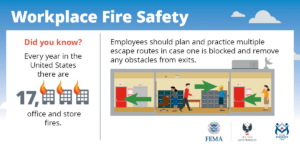October Safety Tip
Workplace Fire Safety
Fire safety is important business. According to OSHA, workplace fires and explosions kill 200 and injure more than 5,000 workers each year. They cost businesses more than $2.3 billion in property damage. The most common causes of workplace fires:
- Faulty electric and equipment – overloaded electrical circuits
- Waste and combustible materials
- Faulty fire alarms and detection systems
- Arson
- Human Error
When OSHA conducts workplace inspections, it checks to see whether employers are complying with OSHA standards for fire safety. OSHA standards require employers to provide proper exits, firefighting equipment, and employee training to prevent fire deaths and injuries in the workplace.
Building Fire Exits
Each workplace building must have at least two means of escape, remote from each other, to be used in a fire emergency. Fire doors must not be blocked or locked to prevent emergency use when employees are within the buildings. Delayed opening of fire doors is permitted when an approved alarm system is integrated into the fire door design. Exit routes from buildings must be clear and free of obstructions and properly marked with signs designating exits from the building. Dock doors are not allowed to be used as fire exits; only man doors are allowed.
Portable Fire Extinguishers
Each workplace building must have a full complement of the proper type of fire extinguisher for the fire hazards present, excepting when employers wish to have employees evacuate instead of fighting small fires. Employees expected or anticipated to use fire extinguishers must be instructed on the hazards of fighting fire, how to properly operate the fire extinguishers available, and what procedures to follow in alerting others to the fire emergency. Annually, those employees expected to use fire extinguishers must receive hands-on-training where they actually are using fire extinguishers to put out fires. Only approved fire extinguishers are permitted to be used in workplaces, and they must be kept in good operating condition. Proper maintenance and inspection of this equipment is required of each employer. Fire extinguishers must be hung up, not placed on the floor or table top because they can be knocked over and could potentially cause serious damage to the employees and/or facility.
Emergency Evacuation Planning
Emergency action plans are required to describe the routes to use and procedures to be followed by employees. Also procedures for accounting for all evacuated employees must be part of the plan. The written plan must be available for employee review. Where needed, special procedures for helping physically impaired employees must be addressed in the plan; also, the plan must include procedures for those employees who must remain behind temporarily.
The preferred means of alerting employees to a fire emergency must be part of the plan and an employee alarm system must be available throughout the workplace complex and must be used for emergency alerting for evacuation. The alarm system may be voice communication or sound signals such as bells, whistles or horns. Employees must know the evacuation signal. Training of all employees in what is to be done in an emergency is required. Employers must review the plan with newly assigned employees so they know correct actions in an emergency and with all employees when the plan is changed.
Fire Prevention Plan
Employers need to implement a written fire prevention plan to complement the emergency evacuation plan to minimize the frequency of evacuation. Stopping unwanted fires from occurring is the most efficient way to handle them. The written plan shall be available for employee review.
Housekeeping procedures for storage and cleanup of flammable materials and flammable waste must be included in the plan. Recycling of flammable waste such as paper is encouraged; however, handling and packaging procedures must be included in the plan.
Procedures for controlling workplace ignition sources such as smoking, welding and burning must be addressed in the plan. Heat producing equipment such as burners, heat exchangers, boilers, ovens, stoves, fryers, etc., must be properly maintained and kept clean of accumulations of flammable residues; flammables are not to be stored close to these pieces of equipment. All employees are to be apprised of the potential fire hazards of their job and the procedures called for in the employer’s fire prevention plan. The plan shall be reviewed with all new employees when they begin their job and with all employees when the plan is changed.
Fire Suppression Systems
Properly designed and installed fixed fire suppression systems enhance fire safety in the workplace. Automatic sprinkler systems throughout the workplace are among the most reliable firefighting means. The fire sprinkler system detects the fire, sounds an alarm and puts the water where the fire and heat are located.
Automatic fire suppression systems require proper maintenance to keep them in serviceable condition. When it is necessary to take a fire suppression system out of service while business continues, the employer must temporarily substitute a fire watch of trained employees standing by to respond quickly to any fire emergency in the normally protected area. The fire watch must interface with the employers’ fire prevention plan and emergency action plan.
If you have questions or need assistance with your safety program, please contact your WCTI Loss Control Consultant.
Bob Wasick, (847) 508-8520, bwasick@ccmsi.com
Jamie Dunn, (630) 776-0377, jamie.dunn@ccmsi.com
Phil Loughnane, (630) 649-6080, ploughnane@ccmsi.com
Anita Worden, (630) 605-6160, aworden@ccmsi.com
Sources: U.S. Department of Labor; www.OSHA.gov

